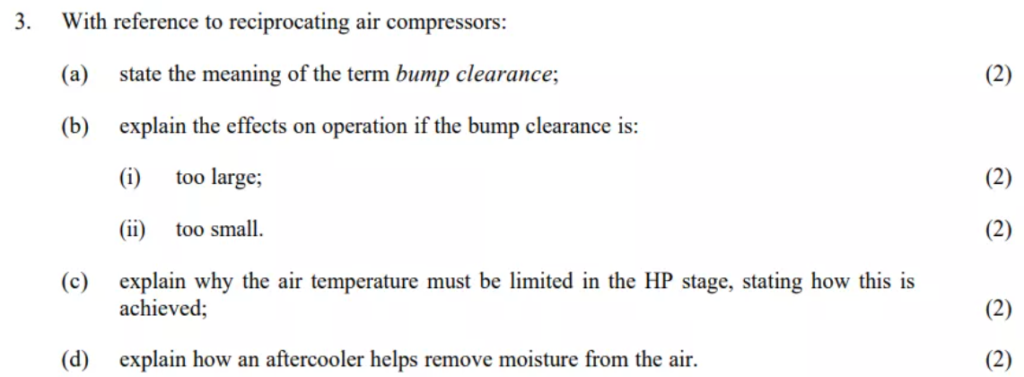
Reciprocating Air Compressor: Bump Clearance and Temperature Control
(a) Bump Clearance:
Bump clearance refers to the minimum distance between the piston and the cylinder head, or between the piston crown and the discharge valve on the cylinder head, at the top dead center (TDC) of the piston stroke. It’s essentially the closest the piston gets to the head or valve at the end of its upward movement.
(b) Effects of Bump Clearance:
(i) Bump Clearance Too Large:
- Reduced Efficiency: Excessive clearance allows for a larger volume of compressed air to remain in the cylinder after discharge, which expands during the intake stroke. This reduces the amount of fresh air that can be drawn into the cylinder, lowering the compressor’s overall efficiency.
- Increased Wear: With a larger gap, the piston experiences increased impact forces against the cylinder head at the end of its stroke, accelerating wear and tear on both components.
(ii) Bump Clearance Too Small:
- Premature Contact and Damage: If the clearance is too tight, the piston might come into contact with the head or valve prematurely during operation. This can cause severe damage to the piston, head, and valve components.
- Increased Friction: A very small clearance creates excessive friction between the piston and cylinder head, leading to increased power consumption and potential overheating.
(c) Limiting Air Temperature in the HP Stage:
Air temperature rises significantly during compression in the high-pressure (HP) stage of a reciprocating compressor. This high temperature can:
- Reduce Lubrication Efficiency: High temperatures can break down the lubricating oil, reducing its effectiveness in protecting moving parts and increasing wear.
- Degrade Air Quality: Excessive heat can cause thermal decomposition of the compressed air, leading to the formation of harmful contaminants and reducing air quality.
- Damage Compressor Components: High temperatures can accelerate wear and tear on valves, seals, and other internal components.
Limiting Air Temperature:
There are two main methods to limit air temperature in the HP stage:
- Intercooling: Air is cooled between compression stages using an intercooler. This removes some of the heat generated during compression in the first stage before the air enters the HP stage for further compression.
- Water Jacketing: The cylinder head and body of the compressor are often water-jacketed. Coolant water circulates around these jackets, absorbing heat from the compressed air within the cylinder and transferring it to a radiator for cooling.
(d) Aftercooler and Moisture Removal:
An aftercooler is a heat exchanger located after the final compression stage of a reciprocating compressor. It functions similarly to an intercooler but cools the compressed air to a lower temperature than what’s achievable with intercooling alone. This helps to:
- Reduce Condensation: By lowering the air temperature, the aftercooler reduces the risk of water vapor in the compressed air condensing into liquid water. This is crucial because water droplets can cause corrosion within the system and damage downstream equipment that relies on clean, dry air.
- Improve Efficiency: Cooler air is denser and requires less energy for further processing or use.
Additional Moisture Removal:
Aftercooling alone might not be sufficient to remove all moisture, especially in humid environments. In such cases, additional equipment like separators or dryers might be used to further remove condensed water from the compressed air stream.